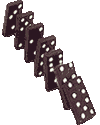 |
Impact of Sieges |
Upon reading that title, the first association a reader may have with the word 'Impact' is that of 'Effect,' as in consequence and influence. Other synonyms, too, work well in this context with 'Impact' such as shock, crash, smash and hit. A siege carried along for a length of time could 'impact' the defenders, the besieged, the surrounding population, the local economy, and several sieges added together, the affairs of a kingdom.
Defending forts and campaigning against forts both were structured on logistics. Those at pulpits could invoke God while those on thrones could claim their rights, but armies required supply. No fort defended its church without a sufficient store of munitions and no cavalry troop rode for its king without fodder for the horses along the way. Commanders with their officers factored into their strategies the how and the where of supply and resupply, conducting campaigns accordingly. Ever wonder why Vienna, capitol of Habsburg Austria, was never struck by any enemy during the Thirty Years War? Getting enough supplies along the roads to that city from the north and west was the crux. (But that was NOT as serious a problem from the southeast as two Turkish armies proved before and after that war.)
Another applicable synonym for 'Impact' is repercussion - and there were many with sieges.
For both sides, sieges required the most of anyone's resources, from coins in a strongbox to cannons to bread. And cannons required gunpowder and cast iron balls. Gunpowder required saltpeter - lots of it - tons of it. Cast iron required forges, and those forges needed charcoal - and charcoal came from the cutting of forests. Bread was made from grain which had to be milled, then diverted from usual civilian use, and the grain itself grown and harvested during a time termed today the "Little Ice Age." Demands of war and sieges in this time did more than ripple though a countryside, more like made waves.
 The scale of warfare changed. The reach of artillery - the range of its
shot - combined with the power of its hit drove the development of the artillery
fort. Because of those, a siege literally became big - more acreage and
more people were
involved than any siege in the Middle Ages. Therefore, significantly more
men were required to hold or take that ground. The manpower requirement
drove up the size of armies. A bigger army required more food, more
munitions and more money. To be able to afford all those 'more's,'
leaders had to extract more from their people and lands. Taxes went from
an irregular imposition to a never-ending burden. Bringing in those taxes
required a cadre of tax collectors who funneled their take to offices set up to
handle and disperse the monies. An infrastructure of civil servants was
born that edged out the old elite of courtiers and nobles. Governance of
people and lands had to be consolidated for efficiency. And who more
appropriate to be on top than a king, instead of a nobility or a synod of bishops.
What we recognize today as the Nation State was coming into being.
Following that came nationalism.
The scale of warfare changed. The reach of artillery - the range of its
shot - combined with the power of its hit drove the development of the artillery
fort. Because of those, a siege literally became big - more acreage and
more people were
involved than any siege in the Middle Ages. Therefore, significantly more
men were required to hold or take that ground. The manpower requirement
drove up the size of armies. A bigger army required more food, more
munitions and more money. To be able to afford all those 'more's,'
leaders had to extract more from their people and lands. Taxes went from
an irregular imposition to a never-ending burden. Bringing in those taxes
required a cadre of tax collectors who funneled their take to offices set up to
handle and disperse the monies. An infrastructure of civil servants was
born that edged out the old elite of courtiers and nobles. Governance of
people and lands had to be consolidated for efficiency. And who more
appropriate to be on top than a king, instead of a nobility or a synod of bishops.
What we recognize today as the Nation State was coming into being.
Following that came nationalism.
The Treaty of Westphalia was signed in 1648 and brought to an end both the Thirty Years War in Germany and the Eighty Years War. Siege warfare in the next 50 years graduated from a craft to a science through the engineering expertise of men like Vauban of France and Coehorn of the Netherlands.
Artillery and its counterpart, the artillery fort, were not the only drivers of change in Europe in this time. The printing press had more to do with the spread of Protestantism than any cannon. Internal reform protected the Catholic Church better than any bastion. The depth of the Little Ice Age did more to stunt the agricultural economy than any passing army. Mounting triangular sails with square sails on the same ship to allow tacking, the same ship also equipped with a stern rudder and compass, spread European commerce and influence around the globe - and carried the artillery and fort plans, not the other way around.
Ask yourself, though, what would be the shape of our society today without the cannon and sieges of half a millenium ago.
| Back |
Thus is concluded this |
|
|